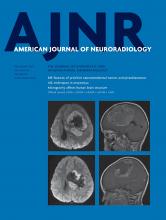Index by author
Aboian, M.S.
- Pediatric NeuroimagingOpen AccessDiffusion Characteristics of Pediatric Diffuse Midline Gliomas with Histone H3-K27M Mutation Using Apparent Diffusion Coefficient Histogram AnalysisM.S. Aboian, E. Tong, D.A. Solomon, C. Kline, A. Gautam, A. Vardapetyan, B. Tamrazi, Y. Li, C.D. Jordan, E. Felton, B. Weinberg, S. Braunstein, S. Mueller and S. ChaAmerican Journal of Neuroradiology November 2019, 40 (11) 1804-1810; DOI: https://doi.org/10.3174/ajnr.A6302
Adalsteinsson, E.
- EDITOR'S CHOICEPediatric NeuroimagingYou have accessComparison of CBF Measured with Combined Velocity-Selective Arterial Spin-Labeling and Pulsed Arterial Spin-Labeling to Blood Flow Patterns Assessed by Conventional Angiography in Pediatric MoyamoyaD.S. Bolar, B. Gagoski, D.B. Orbach, E. Smith, E. Adalsteinsson, B.R. Rosen, P.E. Grant and R.L. RobertsonAmerican Journal of Neuroradiology November 2019, 40 (11) 1842-1849; DOI: https://doi.org/10.3174/ajnr.A6262
This study assesses the accuracy of combined velocity-selective arterial spin-labeling and traditional pulsed arterial spin-labeling CBF measurements in pediatric Moyamoya disease, with comparison with blood flow patterns on conventional angiography. Twenty-two neurologically stable pediatric patients with Moyamoya disease and 5 asymptomatic siblings without frank Moyamoya disease were imaged with velocity-selective arterial spin-labeling, pulsed arterial spin-labeling, and DSA (patients). Qualitatively, velocity-selective arterial spin-labeling perfusion maps reflect the DSA parenchymal phase, regardless of postinjection timing. Conversely, pulsed arterial spin-labeling maps reflect the DSA appearance at postinjection times closer to pulsed arterial spin-labeling postlabeling delay, regardless of vascular phase. ASPECTS comparison showed excellent agreement between arterial spin-labeling and DSA, suggesting velocity-selective arterial spin-labeling and pulsed arterial spin-labeling capture key perfusion and transit delay information, respectively. Velocity-selective arterial spin-labeling offers a powerful approach to image perfusion in pediatric Moyamoya disease due to transit delay insensitivity.
Adams, C.
- Patient SafetyYou have accessDose Reduction While Preserving Diagnostic Quality in Head CT: Advancing the Application of Iterative Reconstruction Using a Live Animal ModelF.D. Raslau, E.J. Escott, J. Smiley, C. Adams, D. Feigal, H. Ganesh, C. Wang and J. ZhangAmerican Journal of Neuroradiology November 2019, 40 (11) 1864-1870; DOI: https://doi.org/10.3174/ajnr.A6258
Aftab, M.
- EditorialYou have accessTime to Discontinue Use of the Term “Hemorrhagic Stroke”M. Aftab and M. SalmanAmerican Journal of Neuroradiology November 2019, 40 (11) 1893; DOI: https://doi.org/10.3174/ajnr.A6240
Ahmed, S.
- Head and Neck ImagingYou have accessDiagnostic Accuracy and Scope of Intraoperative Transoral Ultrasound and Transoral Ultrasound–Guided Fine-Needle Aspiration of Retropharyngeal MassesT.H. Vu, M. Kwon, S. Ahmed, M. Gule-Monroe, M.M. Chen, J. Sun, B.D. Fornage, J.M. Debnam and B. Edeiken-MonroeAmerican Journal of Neuroradiology November 2019, 40 (11) 1960-1964; DOI: https://doi.org/10.3174/ajnr.A6236
Aoki, S.
- Adult BrainOpen AccessBayesian Estimation of CBF Measured by DSC-MRI in Patients with Moyamoya Disease: Comparison with 15O-Gas PET and Singular Value DecompositionS. Hara, Y. Tanaka, S. Hayashi, M. Inaji, T. Maehara, M. Hori, S. Aoki, K. Ishii and T. NariaiAmerican Journal of Neuroradiology November 2019, 40 (11) 1894-1900; DOI: https://doi.org/10.3174/ajnr.A6248
Arat, A.
- NeurointerventionYou have accessPlacement of a Stent within a Flow Diverter Improves Aneurysm Occlusion RatesO. Ocal, A. Peker, S. Balci and A. AratAmerican Journal of Neuroradiology November 2019, 40 (11) 1932-1938; DOI: https://doi.org/10.3174/ajnr.A6237
Asemani, D.
- EDITOR'S CHOICEAdult BrainOpen AccessProlonged Microgravity Affects Human Brain Structure and FunctionD.R. Roberts, D. Asemani, P.J. Nietert, M.A. Eckert, D.C. Inglesby, J.J. Bloomberg, M.S. George and T.R. BrownAmerican Journal of Neuroradiology November 2019, 40 (11) 1878-1885; DOI: https://doi.org/10.3174/ajnr.A6249
Brain MR imaging scans of National Aeronautics and Space Administration astronauts were retrospectively analyzed to quantify pre- to postflight changes in brain structure. Local structural changes were assessed using the Jacobian determinant. Structural changes were compared with clinical findings and cognitive and motor function. Long-duration spaceflights aboard the International Space Station, but not short-duration Space Shuttle flights, resulted in a significant increase in the percentage of total ventricular volume change (10.7% versus 0%). The percentage of total ventricular volume change was significantly associated with mission duration but negatively associated with age. Pre- to postflight structural changes of the left caudate correlated significantly with poor postural control, and the right primary motor area/midcingulate correlated significantly with a complex motor task completion time. These findings suggest that brain structural changes are associated with changes in cognitive and motor test scores and with the development of spaceflight-associated neuro-optic syndrome.
Autti, T.
- Pediatric NeuroimagingYou have accessSusceptibility-Weighted Imaging Findings in AspartylglucosaminuriaA. Tokola, M. Laine, R. Tikkanen and T. AuttiAmerican Journal of Neuroradiology November 2019, 40 (11) 1850-1854; DOI: https://doi.org/10.3174/ajnr.A6288
Balci, S.
- NeurointerventionYou have accessPlacement of a Stent within a Flow Diverter Improves Aneurysm Occlusion RatesO. Ocal, A. Peker, S. Balci and A. AratAmerican Journal of Neuroradiology November 2019, 40 (11) 1932-1938; DOI: https://doi.org/10.3174/ajnr.A6237








